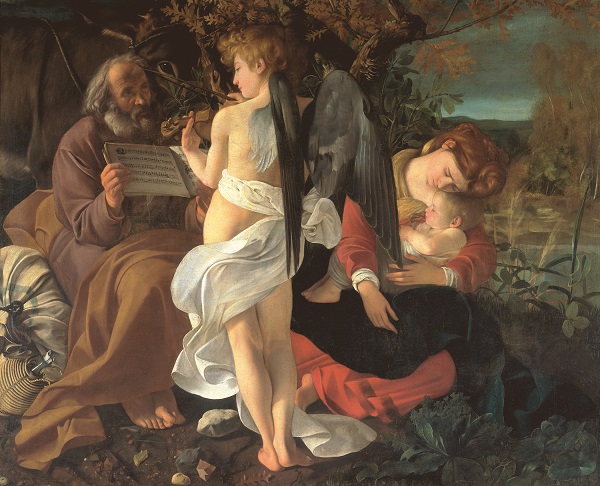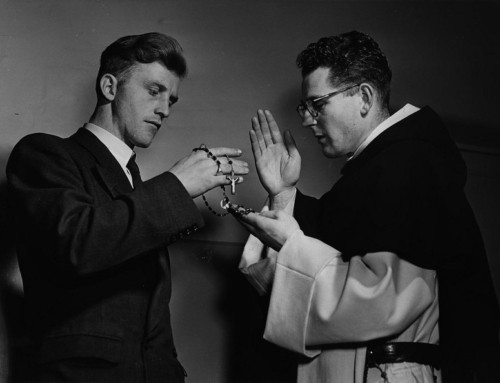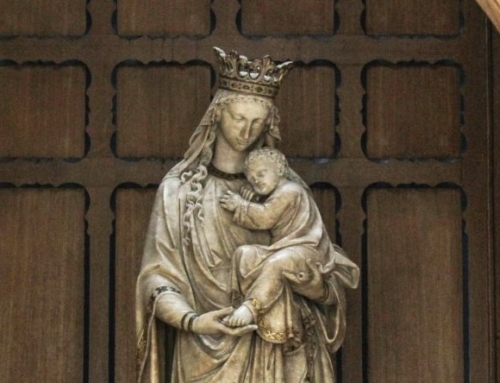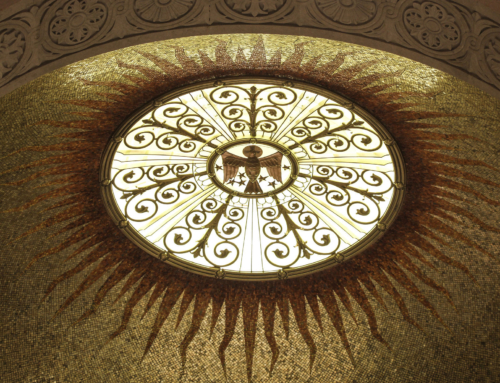The boy rests, innocent of all that has passed; a full-stomached, rosy-cheeked only child who seeks in sleeping to save those who seek in waking to destroy him. The mother, having interrupted the family’s mortal flight to answer her son’s cries of hunger, now wraps him with her body like a mantle, swaddling him with the limbs he made, warming him on the bosom he fashioned. The father sits gently slouched, face wrinkled with age and weariness; he has exhausted all his resources to care for his wife and child, abandoned all he has owned, yet his eyes are lustrous with attention.
Child. Mother. Father. A doleful donkey. The scene is simple. Rest. Weariness. Peace.
But the family is not alone. An angel bursts forth from the space between the mother and the father, careless wings fluttering over the child, nearly brushing him in his sleep. No salutation is needed, no “Do not be afraid,” no announcement of the Lord’s presence; the family knows who he is. There is no fear here. The father’s hands, lifted in praise, reveal themselves to be holding music, a score by which the angel praises the mother and child through beauty offered to Beauty.
Caravaggio’s Rest on the Flight into Egypt (ca. 1596) intoxicates with its splendor; the work easily stole the show at the recent Picturing Mary exhibit at the National Museum of Women in the Arts in Washington, D.C. Its splendor derives from Caravaggio’s unheralded blending of the visible and invisible elements in the scene he depicts. To understand the drama of the painting, we must first mentally remove the luminous angel with his unexpected viol, leaving only Jesus, Mary, and Joseph, haphazardly disposed around a clearing, looking tired and utterly ordinary. If a wanderer were to pass by the scene, his eyes would see only this: a child, a mother, and a father, wanderers and travelers like anyone else, without halos or miracles or radiant light to identify them as central players on the stage of salvation. But to the eyes of faith, the scene erupts with glory: there in the midst of them, emerging from the love of the father and the mother that in turn arises from the child held sleeping, an angel appears—not to give warning or to bestow news, but merely to praise, to delight, to sing God’s goodness. The whole scene is held together spatially by the angel, because the whole scene is held together dramatically by its least active participant: the Christ child. The invisible reality of Jesus is made visible; we see the glory of God.
Caravaggio’s composition is even more striking when considered in the light of the text from which the scene derives. Like many events in the life of the Holy Family beloved of painters and sculptors through the centuries, the source for the rest on the flight into Egypt event is an apocryphal text, in this case a work known as the Gospel of Pseudo-Matthew. Apocryphal Gospels belong to roughly two camps: one set was written by pious but unsophisticated people to fill in the gaps of the biblical stories with imaginative legends, and the other set was written by religious syncretists and practitioners of various Middle-Eastern religions (collectively called “Gnostics”) to incorporate biblical characters and events into their own religious vision. Pseudo-Matthew (ca. 400–800 AD) belongs to the former camp, being intended especially to aid Christian devotion by fleshing out Matthew’s and Luke’s infancy narratives through fanciful stories about Mary’s childhood, the event of Jesus’ birth (both of these borrowed verbatim from the equally fanciful Protoevangelium of James), and the flight into Egypt.
Modern readers cannot help but notice that the authors and compiler of Pseudo-Matthew had more religious enthusiasm than they had literary caution: One night the travelers stayed in a cave which turned out—naturally enough—to be full of dragons (this being long before the days of St. George), at the discovery of which the newborn “Jesus got down from his mother’s lap and stood on his feet before the dragons; and they worshipped Jesus and then departed” (§18); as they headed to Egypt “lions and panthers adored him and accompanied them in the desert” (§19); and, taking a rest underneath a palm tree, the infant Jesus said to the tree, “O tree, bend your branches and refresh my mother with your fruit,” which it obligingly does (§20). The Holy Family was also accompanied by three boys and a girl (§18), forming quite a crowd with all the “lions and the panthers and various kinds of wild beasts” and “oxen and asses and the beasts of burden” which they took with them across the desert to Egypt (§20).
Despite their vast differences in method, the writers of Pseudo-Matthew and Caravaggio have surprisingly similar goals: to make apparent to the senses the invisible splendor that God brings into the world through his Incarnate Son and in his saints. Let me explain.
The rustic, countrified authors of apocryphal texts like Pseudo-Matthew and the Protoevangelium of James have no particular art, literary ability, historical knowledge, or even theological acumen; what they have is a love for Jesus Christ, his mother Mary, and his foster-father Joseph, and a desire to make their holiness obvious to all. The intent is not to invent new teachings, but to convince the listener of what the Christian people have always believed: specifically, that Jesus is Lord. No one can miss the point in this text: Jesus makes clear that he is the eternal Lord of space and time by issuing orders as a newborn, ignoring the laws of nature (later on in the text he has the Holy Family teleport thirty days’ distance in one day), and commanding the obedience of wild creatures. What is at times implicit or veiled in the canonical Scriptures is undeniably, even embarrassingly, overt.
In trying to unveil the hidden holiness of Christ and his parents, however, Pseudo-Matthew and the other apocryphal texts transform these real people into mythological or legendary figures: we may understand that Jesus is God after reading them, but we lose any real sense of his humanity. The lines between grace and magic, between miracles and legend, and between the specificity of history and the generality of myth all become lost.
Caravaggio approaches the rest on the flight into Egypt from a different angle. Here there are no other figures, no retinue, no tame beasts or monsters in thrall. All we see is the Holy Family, a humble beast of burden, and the radiant lightning strike of the musical angel in the center. Caravaggio, too, wants to make the invisible mystery of the Incarnation visible, but in doing so he refuses to compromise the genuine humanity of Jesus, Mary, or Joseph. Only the angel is a signal of the remarkable interior reality of the unremarkable exterior scene; only the music in Joseph’s hands and his prayerful gaze on the angel reveal how interconnected the visible and the invisible aspects of the scene are.
For Caravaggio, the revelation of the invisible cannot sacrifice the coherence of the visible; God is made man in Jesus Christ not to wipe out human nature or the laws of the world humans live in, but to purify humanity, to redeem fallen man, and to bring all people, body and soul, into perfect unity with the Father by the grace of the Holy Spirit. Caravaggio’s genius is to reveal before the physical eyes what is fully apparent only to the eyes of faith: that salvation begins with the birth of a child in Bethlehem, through whom we are made nothing less than “partakers of the divine nature” (2 Pt 1:4) by grace.
One more detail in the Rest on the Flight into Egypt brings out the perpetual relevance of the Incarnation for men and women of every age. The musical score that Joseph is holding is not just a random collection of dots and lines, but an actual motet written by Noel Bauldeweyn in 1519. The piece is called Quam pulchra es, a musical-poetic setting of six verse-fragments from the Song of Songs depicting a dialogue between the Bridegroom and the Bride. Caravaggio’s choice of Bauldeweyn’s piece, composed about seventy-five years before he painted this image, draws the viewer—and the listener—into the invisible drama of salvation that is being rendered visibly on the canvas. The birth of Christ is not a mere historical fact that we reflect on wistfully; it is the present source of our life in grace, our transformation in the image of God, and our incorporation into the body of Christ. Past, present, and future burst into polyphonic song to accompany the angel’s musical articulation of Mary and Joseph’s praise of the infant Jesus.
The text of the motet, placed in the scene of the rest on the flight into Egypt, completes Caravaggio’s visual rendering of the invisible life of grace by making it audible as well:
Quam pulchra es et quam decora
carissima in deliciis
Statura tua assimilata est palmæ,
et ubera tua botris
caput tuum ut carmelus
collum tuum sicut turris eburnea
Sponsa:
Veni dilecte mi; egrediamur in agrum
et videamus si flores fructus parturiunt,
si floruerunt mala punica.
Ibi dabo tibi ubera mea
How beautiful and fair you are, my beloved,
most sweet in your delights.
Your stature is like a palm-tree,
and your breasts are like fruit.
Your head is like Mount Carmel
and your neck is like a tower of ivory.
Bride:
Come, my beloved, let us go into the fields
and see if the blossoms have born fruit,
and if the pomegranates have flowered.
There will I give my breasts to you.
Caravaggio has led us out into the far fields, where the “beautiful and fair” Virgin Mother has finished giving physical food to the “beloved” who has given her every beauty by filling her with every grace. Joseph here plays the role of the inspired author of the Song of Songs, who sings the praises of the Bridegroom and the Bride by drawing all peoples of all times into that one song of love. In the quiet majesty of his painting, Caravaggio has done what the faithful authors of apocryphal works like Pseudo-Matthew could never do with all their bombast and wonder: he has let us see and hear the hidden glory of the Incarnate God. May God give us eyes to see and ears to hear.
To download a printable PDF of this Article from
Dominicana Journal, Summer 2015, Vol LVIII, No. 1, CLICK HERE.




